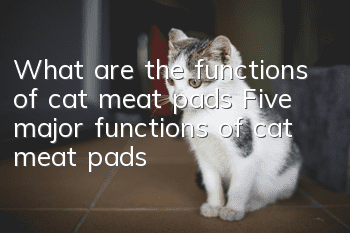What are the functions of cat meat pads? Five major functions of cat meat pads

Cat meat pads act as shock absorbers
Cat’s meat pads are actually a collection of fat and a large amount of elastic fibers. They are distributed between the palms and toes of cats. When the cat falls from a high place, the thick meat pads can act as a shock absorber.
Cat meat pads function as radiators
Sweat glands are distributed in the cat’s flesh pads. When the cat feels hot and needs to perspire, it will dissipate heat through the small flesh pads, so especially in summer, it sometimes feels wet in the flesh pads. The only place on a cat's body that has sweat glands is its flesh pads. In hot weather, cats can only rely on their flesh pads to dissipate heat and sweat. All flesh pads are also equivalent to radiators on cats.
Cat meat pads function as silencers
The padded paws make very little noise when walking on the road, giving cats a greater advantage when hunting and making them less likely to be discovered by prey or enemies. , the cat makes almost no sound when walking. These are the fleshy pads on the soles of the feet, which give cats a great advantage when hunting in the wild, so as to seize the opportunity to attack. This organ that seeks advantages and avoids harm has been genetically inherited to this day.
Cat meat pads function as anti-slip pads
The cat’s pads look very smooth and tender, but when the cat is highly concentrated, the pads will sweat, making it less likely for the cat to slip during the next run.
Cat meat pads function as sensors
The thick meat pad is actually covered with very sensitive nerves, so it can feel the smallest vibrations on the ground. This evolution is of course related to hunting. Cats can use it to detect mouse activity in underground burrows. Deaf cats have more receptors in their pads and can hear more through receptors in their paws.
Cat meat pads have a three-dimensional effect
Foot pads are often used to feel the nature, size, shape and distance of unfamiliar objects. People can often see a cat stretching out one foot, gently tapping an object, then pressing it tightly, and finally pressing its nose against the object for sniffing inspection. The pads can also sense vibrations and can even hear sounds through the pads like ears. Because of this, cats are particularly afraid of vibrations in their pads.
- How to make a cat smart and obedient
- What should I do if my cat eats oil?
- Ways for cats to live in harmony with their owners, cat training!
- How long does a blue cat live?
- How to train a cat to stand gracefully, a must-read for cat owners!
- How to train Ragdoll cats well?
- How to induce a cat to defecate? How to train a cat to solve constipation!
- Why do cats have the instinct to catch mice? It turns out that’s the reason!
- What should I do if my British shorthair cat develops catnip?
- What to do if a kitten has lice? Cut off the source of infection to the cat



